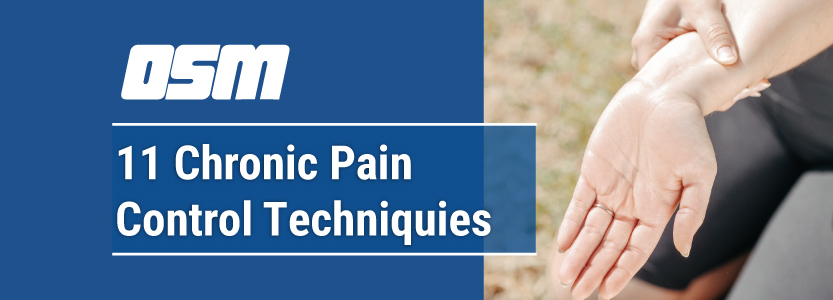11 Chronic Pain Control Techniques
Article featured on Spine-Health
While preparing for any chronic pain coping method, it is important to learn how to use focus and deep breathing techniques to relax the body. Learning to relax takes practice, especially while in pain. It is beneficial to be able to release muscle tension throughout the body and start to remove attention from the pain.
Coping techniques for chronic pain begin with controlled deep breathing, as follows:
- Setting oneself in a relaxed, reclining position in a dark room and either closing both eyes or focusing on a point.
- Slowing down the breathing and taking deep breaths, using the chest (and not the abdomen). If distracted, thinking of a word, such as “relax,” to help control the breathing and gain focus can be helpful. This process may be performed by repeating the syllable “re” while breathing in and “lax” while breathing out.
- Continue with about 2 to 3 minutes of controlled breathing.
After relaxation and focus are achieved, imagery techniques can be used.
Eleven specific imagery and chronic pain control techniques that are effective for pain management include:
- Altered focus. This is a favorite technique for demonstrating how powerfully the mind can alter sensations in the body. Altered focus includes focusing attention on a specific non-painful part of the body (hand, foot, etc.) and altering sensation in that part of the body. For example, imagining the hand warming up. This process takes the mind away from focusing on the source of pain, such as in the back or neck.
- Dissociation. As the name implies, this chronic pain technique involves mentally separating the painful body part from the rest of the body, or imagining the body and mind as separate, with the chronic pain distant from one’s mind. For example, imagine the painful lower back sitting on a chair across the room and telling it to stay sitting there, far away from the mind.
- Sensory splitting. This technique involves dividing the painful sensation (pain, burning, pins and needles) into separate parts. For example, if the leg pain or back pain feels hot, the sensation of the heat is focused upon (and not on the hurting).
- Mental anesthesia. This method involves imagining an injection of numbing anesthetic (like Novocain) into the painful area. For example, imagining a numbing solution being injected into the lower back. Similarly, imagining a soothing and cooling ice pack being placed onto the painful area can help reduce the perception of pain.
- Mental analgesia. Building on the mental anesthesia concept, this technique involves imagining an injection of a strong pain-relieving agent, such as morphine, into the painful area. An alternative method is imagining the brain producing a massive amount of endorphins, the natural pain-relieving substance of the body, and having it flow to the painful areas.
- Transfer. Using the mind to produce altered sensations, such as heat, cold, or anesthetic in a non-painful hand, and then placing the hand on the painful area. This pleasant, altered sensation is then envisioned to be transferred into the painful area.
- Age progression/regression. Using the mind’s eye to project oneself forward or backward in time to a pain-free state or experiencing much less pain. Then instructing oneself to act “as if” this image were true.
- Symbolic imagery. Envisioning a symbol that represents chronic pain, such as a loud, irritating noise or a painfully bright light bulb. Gradually reducing the irritating qualities of this symbol, for example dimming the light or reducing the volume of the noise, thereby reducing the pain.
- Positive imagery. Focusing your attention on a pleasant place, such as the beach, or the mountains, etc. – where a carefree, safe, and relaxed state may be achieved.
- Counting. Silent counting is a good way to deal with painful episodes. Counting may include the number of breaths, holes in an acoustic ceiling, floor tiles, or simply conjuring up mental images and counting them.
- Pain movement. Moving chronic back pain from one area of your body to another, where the pain is easier to cope with. For example, mentally moving chronic back pain or neck pain into the hand, or even out of the hand into the air.
Some of these techniques are probably best learned with the help of a professional, and it usually takes practice for these methods to become effective in helping alleviate chronic pain. It is often advisable to work on pain coping strategies for about 30 minutes 3 times a week. With practice relaxation and chronic pain control can become strong and last for a long time.
After learning these techniques, chronic pain relief and relaxation can be produced with just a few deep breaths. These techniques can then be used while being engaged in any activity, working, talking, etc. With enough experience, a greater sense of control over the chronic pain and its effects on life can be felt.
The Orthopedic & Sports Medicine Center of Oregon is an award-winning, board-certified orthopedic group located in downtown Portland Oregon. We utilize both surgical and nonsurgical means to treat musculoskeletal trauma, spine diseases, sports injuries, degenerative diseases, infections, tumors and congenital disorders.
Our mission is to return our patients back to pain-free mobility and full strength as quickly and painlessly as possible using both surgical and non-surgical orthopedic procedures.
Our expert physicians provide leading-edge, comprehensive care in the diagnosis and treatment of orthopedic conditions, including total joint replacement and sports medicine. We apply the latest state-of-the-art techniques in order to return our patients to their active lifestyle.
If you’re looking for compassionate, expert orthopedic surgeons in Portland Oregon, contact OSM today.
Phone:
503-224-8399
Address
17355 Lower Boones Ferry Rd Suite 100A
Lake Oswego, OR 97035
Hours
Monday–Friday
8:00am – 4:30pm



